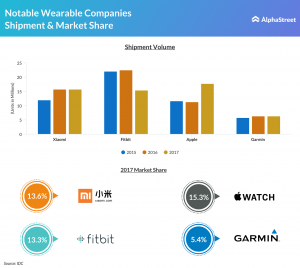Apple is busy perfecting its prowess in non-core areas of the business. Its renewed focus on the wearables sphere indicates Apple is gradually shedding the image of a ‘smartphone-notebook’ company.
If latest statistics are any indication, the company will soon be giving the likes of Fitbit and Xiaomi a run for their money; and the credit goes to its smartwatch.
It’s a commendable feat to rule a multibillion-dollar consumer market like that of wearable gadgets. The final months of last year witnessed robust growth in the shipments of wearables, and the volumes hit a record high when the year came to a close.
In the fourth quarter, global wearables shipments increased about 8% to a whopping 38 million units. In the whole of 2017, shipments rose 10% to more than 115 million units.
Recent trends show that in addition to athletes and sportspersons, a large section of the urban population across the world have made wearable gadgets an integral part of their lives, further brightening the prospects of the sector.
So, what has changed in recent years that brought so much vigor into the wearables market? The first and foremost factor – gadgets are getting smarter and gradually replacing smartphones. Falling prices and widening acceptance in the fields of sports and healthcare are the other attractions.
The final months of last year witnessed robust growth in the shipments of wearables
For companies and service providers the wearables market is the right avenue to push additional software and related accessories.
Meanwhile, due to increasing awareness, customers are becoming more and more brand conscious, which is a trend that bodes well for the likes of Apple. It is expected that being a trendsetter, Apple Watch is set to revolutionize the way people communicate with each other.
Fitbit, the next big name in smartwatches after Apple, intensified the promotion of its brand last year and adopted measures to broaden its healthcare portfolio. Shipments at Fitbit, which recently took a deviation from core activities by venturing into development of the FitbitOS platform, dropped 17% annually to 5.4 million in the fourth quarter.
A major chunk of Xiaomi’s revenue continues to come from its fitness tracker MiBand 2, which was launched a long time ago. Last year, the company rolled out MiBand HRX, a revamped version of its predecessor. In the fourth quarter, Xiaomi’s shipments dipped 4.5% to 4.9 million units.
Most Popular
Earnings Preview: What to look for when Netflix (NFLX) reports Q4 2025 results
Netflix, Inc. (NASDAQ: NFLX) is expected to report Q4 results on January 20, amid expectations for strong revenue and earnings growth. The company is navigating a shifting streaming landscape where
What to look for when United Airlines (UAL) reports its Q4 2025 earnings results
Shares of United Airlines (NASDAQ: UAL) stayed red on Thursday. The stock has gained 15% over the past three months. The airline is scheduled to report its earnings results for
Infographic: How Constellation Brands (STZ) performed in Q3 2026
Constellation Brands, Inc. (NYSE: STZ) reported net sales of $2.22 billion for the third quarter of 2026, down 10% year-over-year. Organic net sales were down 2%. Net income attributable to
